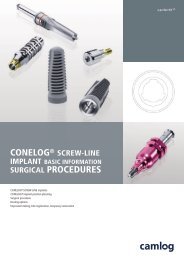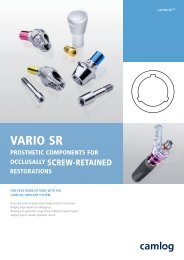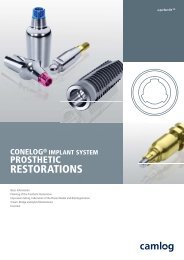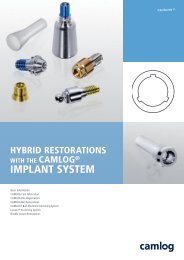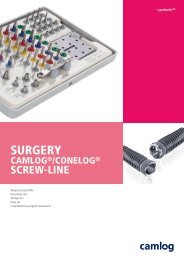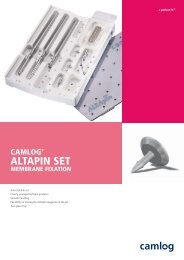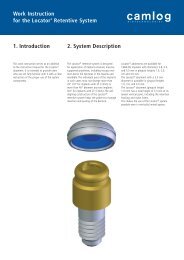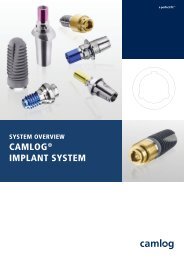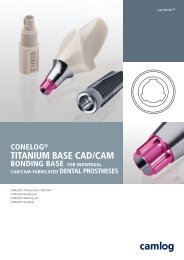1 Surgery CAMLOG Compendium
1 Surgery CAMLOG Compendium
1 Surgery CAMLOG Compendium
You also want an ePaper? Increase the reach of your titles
YUMPU automatically turns print PDFs into web optimized ePapers that Google loves.
2. Anamnesis<br />
Introduction<br />
The medical history and diagnosis are<br />
not different from the evaluation procedures<br />
required for other dental surgery<br />
or restorative treatments. For this reason<br />
only the specific points for perio-implant<br />
prosthetic treatments are described<br />
below.<br />
The general, social and special (dental)<br />
medical history considers all general<br />
medical contraindications and diseases<br />
that could affect the microcirculation or<br />
the patient's suitability for the proposed<br />
implant-based restoration. Risk factors<br />
such as nicotine, alcohol and drug abuse<br />
are confidentially evaluated, discussed<br />
and documented.<br />
The patient's psycological and psychosocial<br />
situation gives an indication of the<br />
compliance that can be expected and<br />
will influence the planning of the treatment<br />
and the future prosthetic design.<br />
General<br />
The general medical history should<br />
include not only the disease history but<br />
also regular medication usage and the<br />
possibility of general medical problems<br />
that could adversely affect an implantbased<br />
prosthetic treatment.<br />
Special (dental)<br />
The special medical history must clarify<br />
the reasons for the current situation of<br />
the oral system.<br />
It may provide information on systemic<br />
diseases that may not have been detected<br />
yet. If implants or grafts were previously<br />
placed this may be important for<br />
assessment of the bone quality.<br />
3. Examinations<br />
Clinical<br />
In addition to all standard extraoral<br />
examinations, the soft tissue profile and<br />
support of the soft tissues (especially in<br />
the maxilla) are a critical factor in<br />
designing the prosthesis. If a large discrepancy<br />
exists between the required<br />
labial tooth position and the proposed<br />
implant position, the use of a removable<br />
denture (bar-structure, telescopic crown,<br />
ball abutment, Locator ® ) may be necessary<br />
for loading reasons.<br />
The results of the intraoral examinations<br />
determine which teeth can be saved. The<br />
standard of hygiene is evaluated and a<br />
check of the soft tissue for pathological<br />
conditions is performed for information<br />
on the patient's possible compliance<br />
during and after treatment.<br />
The static and dynamic occlusion, interalveolar<br />
distance, and centric relations<br />
are checked. Temporomandibular joint<br />
disorders are addressed before the start<br />
of treatment.<br />
All findings indicating elevated stress on<br />
the masticatory system (e.g., bruxism)<br />
must be investigated, documented, and<br />
considered in the prosthetic planning.<br />
The status of the soft tissue in edentulous<br />
arch segments (width and thickness<br />
of the attached gingiva) must be<br />
checked and the extension of the alveolar<br />
ridge must be evaluated for its suitability<br />
as a possible implant site.<br />
Planning<br />
General Information<br />
21




